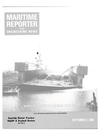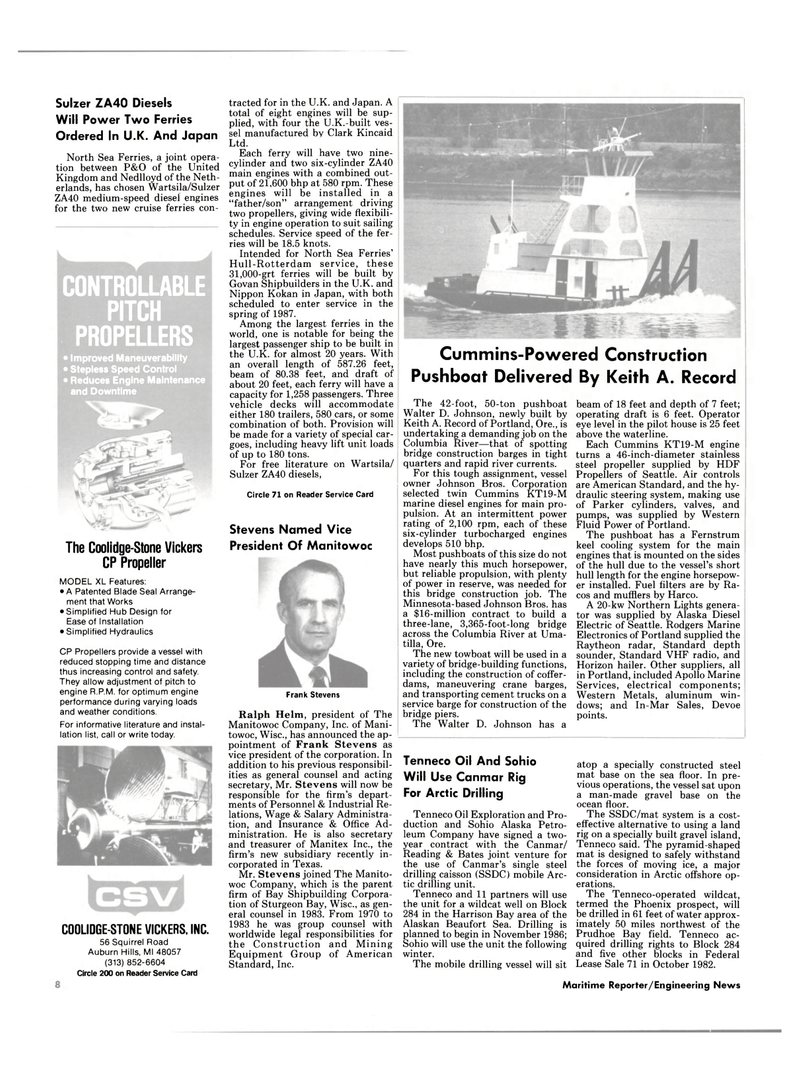
Page 6: of Maritime Reporter Magazine (September 1985)
Read this page in Pdf, Flash or Html5 edition of September 1985 Maritime Reporter Magazine
Sulzer ZA40 Diesels
Will Power Two Ferries
Ordered In U.K. And Japan
North Sea Ferries, a joint opera- tion between P&O of the United
Kingdom and Nedlloyd of the Neth- erlands, has chosen Wartsila/Sulzer
ZA40 medium-speed diesef engines for the two new cruise ferries con-
CONTROLLABLE
PITCH
PROPELLERS • Improved Maneuverability • Stepless Speed Control • Reduces Engine Maintenance and Downtime
The Coolidge-Stone Vickers
CP Propeller
MODEL XL Features: • A Patented Blade Seal Arrange- ment that Works • Simplified Hub Design for
Ease of Installation • Simplified Hydraulics
CP Propellers provide a vessel with reduced stopping time and distance thus increasing control and safety.
They allow adjustment of pitch to engine R.P.M. for optimum engine performance during varying loads and weather conditions.
For informative literature and instal- lation list, call or write today.
COOLIDGE-STONE VICKERS. INC. 56 Squirrel Road
Auburn Hills, Ml 48057 (313) 852-6604
Circle 200 on Reader Service Card tracted for in the U.K. and Japan. A total of eight engines will be sup- plied, with four the U.K.-built ves- sel manufactured by Clark Kincaid
Ltd.
Each ferry will have two nine- cylinder and two six-cylinder ZA40 main engines with a combined out- put of 21,600 bhp at 580 rpm. These engines will be installed in a "father/son" arrangement driving two propellers, giving wide flexibili- ty in engine operation to suit sailing schedules. Service speed of the fer- ries will be 18.5 knots.
Intended for North Sea Ferries'
Hull-Rotterdam service, these 31,000-grt ferries will be built by
Govan Shipbuilders in the U.K. and
Nippon Kokan in Japan, with both scheduled to enter service in the spring of 1987.
Among the largest ferries in the world, one is notable for being the largest passenger ship to be built in the U.K. for almost 20 years. With an overall length of 587.26 feet, beam of 80.38 feet, and draft of about 20 feet, each ferry will have a capacity for 1,258 passengers. Three vehicle decks will accommodate either 180 trailers, 580 cars, or some combination of both. Provision will be made for a variety of special car- goes, including heavy lift unit loads of up to 180 tons.
For free literature on Wartsila/
Sulzer ZA40 diesels,
Circle 71 on Reader Service Card
Stevens Named Vice
President Of Manitowoc
Frank Stevens
Ralph Helm, president of The
Manitowoc Company, Inc. of Mani- towoc, Wise., has announced the ap- pointment of Frank Stevens as vice president of the corporation. In addition to his previous responsibil- ities as general counsel and acting secretary, Mr. Stevens will now be responsible for the Arm's depart- ments of Personnel & Industrial Re- lations, Wage & Salary Administra- tion, and Insurance & Office Ad- ministration. He is also secretary and treasurer of Manitex Inc., the firm's new subsidiary recently in- corporated in Texas.
Mr. Stevens joined The Manito- woc Company, which is the parent firm of Bay Shipbuilding Corpora- tion of Sturgeon Bay, Wise., as gen- eral counsel in 1983. From 1970 to 1983 he was group counsel with worldwide legal responsibilities for the Construction and Mining
Equipment Group of American
Standard, Inc.
Cummins-Powered Construction
Pushboat Delivered By Keith A. Record
The 42-foot, 50-ton pushboat
Walter D. Johnson, newly built by
Keith A. Record of Portland, Ore., is undertaking a demanding job on the
Columbia River—that of spotting bridge construction barges in tight quarters and rapid river currents.
For this tough assignment, vessel owner Johnson Bros. Corporation selected twin Cummins KT19-M marine diesel engines for main pro- pulsion. At an intermittent power rating of 2,100 rpm, each of these six-cylinder turbocharged engines develops 510 bhp.
Most pushboats of this size do not have nearly this much horsepower, but reliable propulsion, with plenty of power in reserve, was needed for this bridge construction job. The
Minnesota-based Johnson Bros, has a $16-million contract to build a three-lane, 3,365-foot-long bridge across the Columbia River at Uma- tilla, Ore.
The new towboat will be used in a variety of bridge-building functions, including the construction of coffer- dams, maneuvering crane barges, and transporting cement trucks on a service barge for construction of the bridge piers.
The Walter D. Johnson has a beam of 18 feet and depth of 7 feet; operating draft is 6 feet. Operator eye level in the pilot house is 25 feet above the waterline.
Each Cummins KT19-M engine turns a 46-inch-diameter stainless steel propeller supplied by HDF
Propellers of Seattle. Air controls are American Standard, and the hy- draulic steering system, making use of Parker cylinders, valves, and pumps, was supplied by Western
Fluid Power of Portland.
The pushboat has a Fernstrum keel cooling system for the main engines that is mounted on the sides of the hull due to the vessel's short hull length for the engine horsepow- er installed. Fuel filters are by Ra- cos and mufflers by Harco.
A 20-kw Northern Lights genera- tor was supplied by Alaska Diesel
Electric of Seattle. Rodgers Marine
Electronics of Portland supplied the
Raytheon radar, Standard depth sounder, Standard VHF radio, and
Horizon hailer. Other suppliers, all in Portland, included Apollo Marine
Services, electrical components;
Western Metals, aluminum win- dows; and In-Mar Sales, Devoe points.
Tenneco Oil And Sohio
Will Use Canmar Rig
For Arctic Drilling
Tenneco Oil Exploration and Pro- duction and Sohio Alaska Petro- leum Company have signed a two- year contract with the Canmar/
Reading & Bates joint venture for the use of Canmar's single steel drilling caisson (SSDC) mobile Arc- tic drilling unit.
Tenneco and 11 partners will use the unit for a wildcat well on Block 284 in the Harrison Bay area of the
Alaskan Beaufort Sea. Drilling is planned to begin in November 1986;
Sohio will use the unit the following winter.
The mobile drilling vessel will sit atop a specially constructed steel mat base on the sea floor. In pre- vious operations, the vessel sat upon a man-made gravel base on the ocean floor.
The SSDC/mat system is a cost- effective alternative to using a land rig on a specially built gravel island,
Tenneco said. The pyramid-shaped mat is designed to safely withstand the forces of moving ice, a major consideration in Arctic offshore op- erations.
The Tenneco-operated wildcat, termed the Phoenix prospect, will be drilled in 61 feet of water approx- imately 50 miles northwest of the
Prudhoe Bay field. Tenneco ac- quired drilling rights to Block 284 and five other blocks in Federal
Lease Sale 71 in October 1982. 8 Maritime Reporter/Engineering News

 5
5

 7
7
